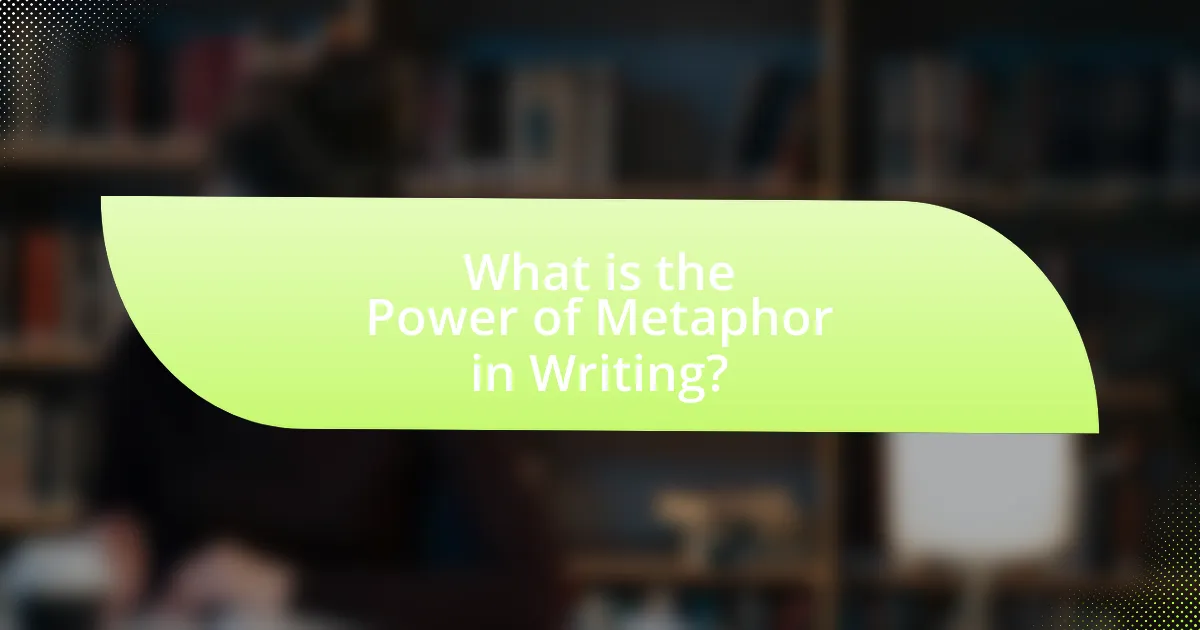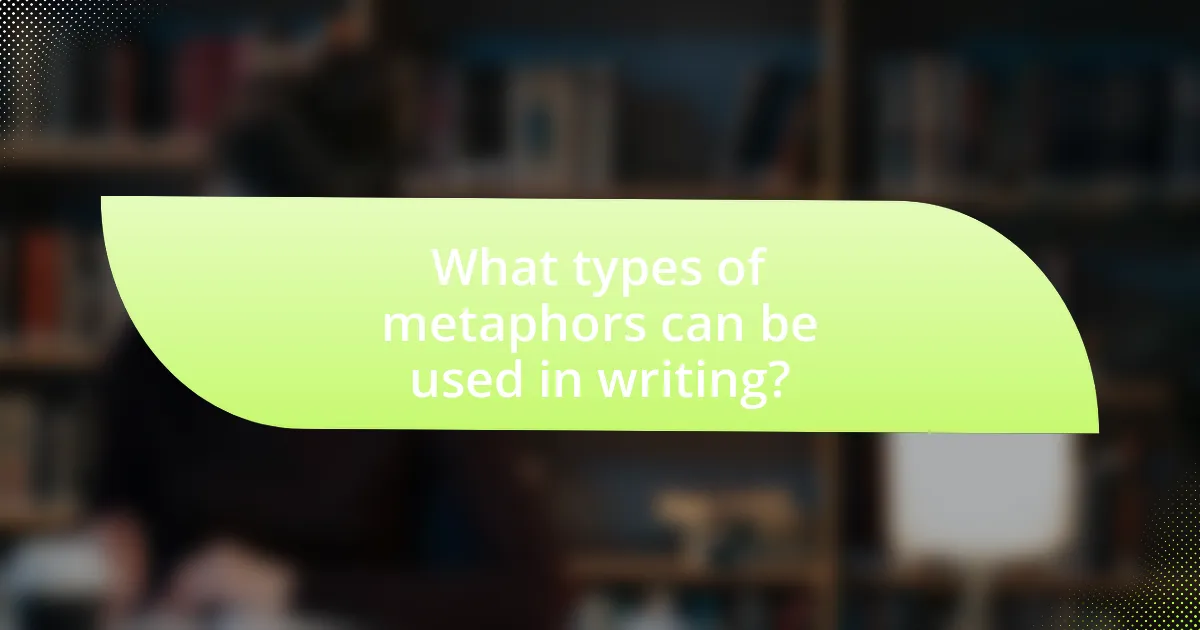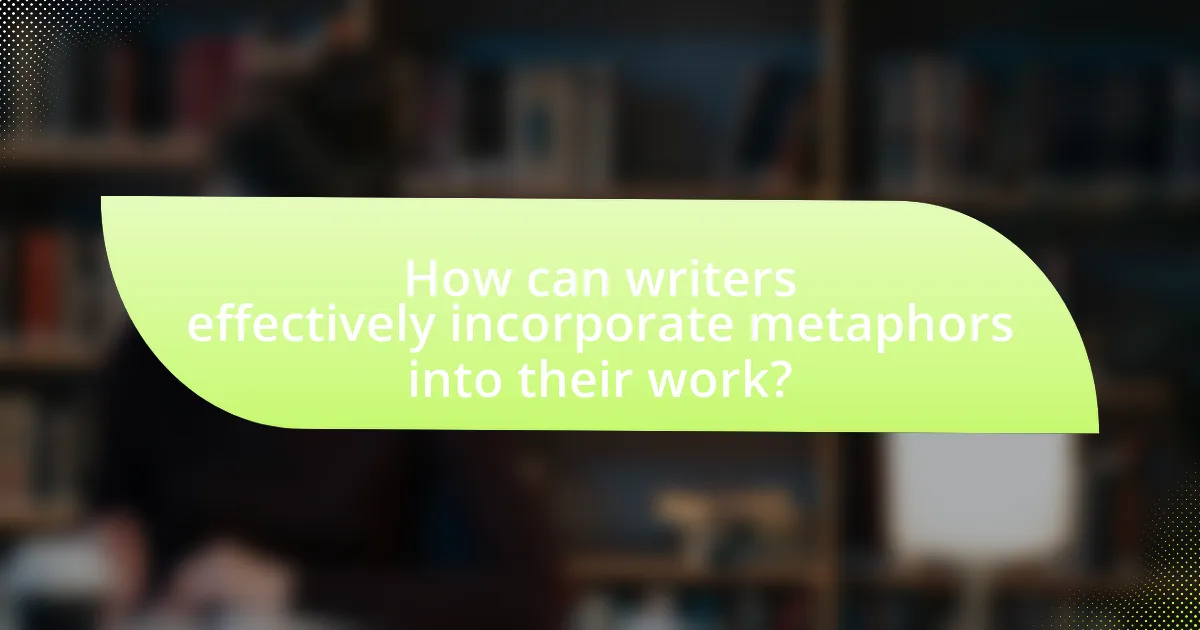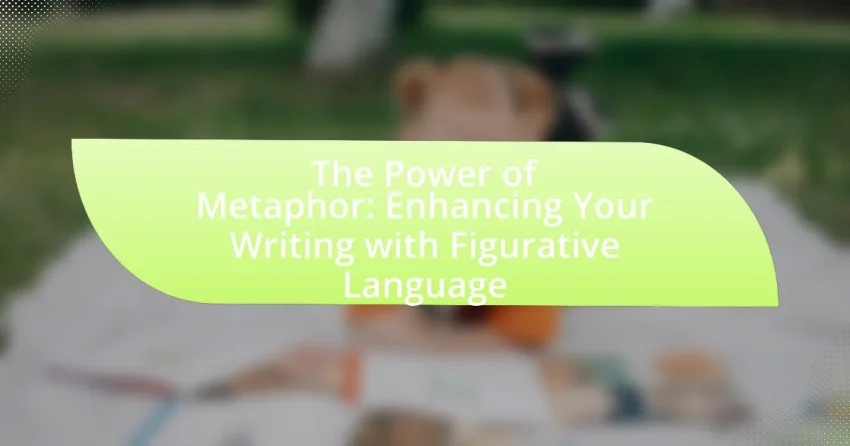The article explores the power of metaphor in writing, emphasizing its role in creating vivid imagery and conveying complex ideas succinctly. It discusses how metaphors enhance the effectiveness of writing by facilitating deeper understanding and emotional engagement, supported by research on cognitive processes. Key elements that make metaphors impactful, such as clarity and emotional resonance, are outlined, along with various types of metaphors and their specific functions in different writing genres. The article also addresses common pitfalls in metaphor usage and offers practical tips for writers to effectively incorporate metaphors into their work, ultimately highlighting the significance of figurative language in enriching narratives.

What is the Power of Metaphor in Writing?
The power of metaphor in writing lies in its ability to create vivid imagery and convey complex ideas succinctly. Metaphors allow writers to draw comparisons that enhance understanding and evoke emotional responses, making abstract concepts more relatable. For instance, Shakespeare’s use of metaphors in “Romeo and Juliet” illustrates love as a “star-crossed” fate, which deepens the audience’s emotional engagement with the characters’ struggles. This technique not only enriches the narrative but also aids in memory retention, as readers often remember metaphorical expressions more vividly than literal descriptions.
How does metaphor enhance the effectiveness of writing?
Metaphor enhances the effectiveness of writing by creating vivid imagery and facilitating deeper understanding. By comparing one thing to another, metaphors allow readers to grasp complex ideas through familiar concepts, making the text more relatable and engaging. For instance, in literature, Shakespeare’s use of metaphors, such as “All the world’s a stage,” conveys the idea of life as a performance, enriching the reader’s interpretation. This technique not only captures attention but also evokes emotions, leading to a more memorable and impactful reading experience.
What are the key elements that make metaphors impactful?
The key elements that make metaphors impactful include clarity, emotional resonance, and vivid imagery. Clarity ensures that the metaphor is easily understood, allowing the audience to grasp the intended meaning without confusion. Emotional resonance connects the metaphor to the audience’s feelings, enhancing engagement and relatability. Vivid imagery creates strong mental pictures, making the metaphor memorable and effective in conveying complex ideas. Research indicates that metaphors can significantly enhance comprehension and retention of information, as demonstrated in studies by Lakoff and Johnson, which highlight how metaphors shape thought processes and influence perception.
How do metaphors influence reader perception and understanding?
Metaphors significantly influence reader perception and understanding by creating vivid imagery and facilitating emotional connections. When a writer employs metaphors, they enable readers to grasp complex ideas through relatable comparisons, enhancing comprehension. For instance, a metaphor like “time is a thief” conveys the idea of time stealing moments from life, allowing readers to emotionally resonate with the concept of fleeting time. Research by Lakoff and Johnson in “Metaphors We Live By” demonstrates that metaphors shape our thoughts and actions, indicating their profound impact on cognitive processes. Thus, metaphors serve as powerful tools in writing, shaping how readers interpret and engage with the text.
Why is figurative language important in writing?
Figurative language is important in writing because it enhances expression and engages readers’ emotions. By using metaphors, similes, and other figures of speech, writers can create vivid imagery and convey complex ideas more effectively. Research indicates that figurative language can improve comprehension and retention of information, as it allows readers to relate to the content on a deeper level. For instance, a study published in the journal “Cognitive Science” by researchers from the University of California found that figurative expressions can facilitate understanding by activating mental imagery, making the text more memorable.
What role does figurative language play in creative expression?
Figurative language plays a crucial role in creative expression by enhancing imagery and emotional resonance in writing. It allows writers to convey complex ideas and feelings through metaphors, similes, and other figures of speech, making their work more relatable and impactful. For instance, a study by the University of California found that metaphors can significantly improve comprehension and retention of information, demonstrating their effectiveness in engaging readers. This ability to evoke vivid imagery and deep emotions is essential for creating memorable and powerful narratives.
How does figurative language contribute to emotional resonance in writing?
Figurative language enhances emotional resonance in writing by creating vivid imagery and evoking strong feelings. This type of language, including metaphors and similes, allows readers to connect with the text on a deeper level by appealing to their senses and emotions. For instance, a metaphor like “time is a thief” conveys the idea of lost moments in a way that resonates emotionally, making the reader reflect on their own experiences with time. Research indicates that figurative language activates emotional processing areas in the brain, leading to a more profound engagement with the narrative. Thus, the use of figurative language not only enriches the text but also fosters a stronger emotional connection between the reader and the writing.

What types of metaphors can be used in writing?
There are several types of metaphors that can be used in writing, including direct metaphors, implied metaphors, extended metaphors, and mixed metaphors. Direct metaphors make a straightforward comparison between two unlike things, such as “Time is a thief.” Implied metaphors suggest a comparison without explicitly stating it, for example, “He sailed through his exams,” implying he handled them easily. Extended metaphors develop a comparison over several lines or throughout an entire work, enhancing thematic depth, as seen in Shakespeare’s “All the world’s a stage.” Mixed metaphors combine elements from different metaphors, often leading to humorous or confusing effects, such as “We’ll burn that bridge when we get to it.” Each type serves to enrich language and convey complex ideas succinctly.
How do different types of metaphors serve various writing purposes?
Different types of metaphors serve various writing purposes by enhancing imagery, conveying complex ideas, and evoking emotions. For instance, similes and analogies clarify concepts by drawing comparisons, making abstract ideas more relatable. Symbolic metaphors can deepen thematic elements, allowing writers to convey underlying messages without explicit statements. Additionally, extended metaphors can create a cohesive narrative thread, enriching the text’s emotional resonance. Research indicates that effective use of metaphor can improve reader engagement and comprehension, as demonstrated in studies on cognitive linguistics, which show that metaphors shape how individuals understand and relate to information.
What are the differences between similes and metaphors?
Similes and metaphors are both figures of speech used to make comparisons, but they differ in their structure and usage. A simile explicitly compares two different things using the words “like” or “as,” such as “as brave as a lion,” while a metaphor makes an implicit comparison by stating that one thing is another, for example, “time is a thief.” This distinction is significant because similes create a more direct and clear comparison, whereas metaphors often convey deeper meanings and associations by suggesting a relationship without using comparative words.
How can extended metaphors enhance narrative depth?
Extended metaphors enhance narrative depth by creating a sustained comparison that deepens the reader’s understanding of themes and characters. This technique allows writers to draw intricate parallels between seemingly unrelated concepts, enriching the narrative with layers of meaning. For instance, in literature, an extended metaphor can illustrate a character’s emotional journey by likening it to a physical landscape, thereby providing insight into their internal struggles. This method not only engages readers but also encourages them to explore the text on a more profound level, as evidenced by works like Shakespeare’s “All the world’s a stage,” where life is compared to a theatrical performance, inviting reflection on human existence.
What are some common pitfalls when using metaphors?
Common pitfalls when using metaphors include overcomplication, ambiguity, and cultural misinterpretation. Overcomplication occurs when metaphors become too intricate, confusing the reader rather than enhancing understanding. Ambiguity arises when a metaphor can be interpreted in multiple ways, leading to miscommunication. Cultural misinterpretation happens when a metaphor is rooted in a specific culture, making it inaccessible or confusing for audiences from different backgrounds. These pitfalls can detract from the intended message and weaken the overall impact of the writing.
How can clichés undermine the effectiveness of metaphors?
Clichés undermine the effectiveness of metaphors by diluting their originality and impact. When metaphors become clichéd, they lose their ability to evoke fresh imagery or provoke thought, as they are often overused and predictable. For instance, phrases like “time is money” or “the world is your oyster” have become so commonplace that they fail to engage the audience’s imagination. This lack of engagement diminishes the metaphor’s power to convey complex ideas or emotions, making the writing less compelling and memorable. Therefore, the reliance on clichés can render metaphors ineffective in enhancing the richness of language and communication.
What strategies can writers use to avoid mixed metaphors?
Writers can avoid mixed metaphors by ensuring clarity and consistency in their figurative language. This involves selecting metaphors that align with the same theme or imagery, thereby preventing confusion. For instance, if a writer uses a nautical metaphor, they should stick to that theme throughout the passage, avoiding unrelated imagery like a sports metaphor. Additionally, writers can revise their work by reading it aloud to identify any awkward combinations of metaphors that may not fit together logically. This strategy helps in recognizing and correcting mixed metaphors before finalizing the text.

How can writers effectively incorporate metaphors into their work?
Writers can effectively incorporate metaphors into their work by ensuring that the metaphors are relevant to the themes and emotions they wish to convey. This relevance enhances the reader’s understanding and connection to the text. For instance, using a metaphor like “time is a thief” can succinctly express the idea of lost opportunities, making the concept more relatable and vivid. Research shows that metaphors can improve comprehension and retention of information, as they create mental images that resonate with readers, thereby reinforcing the intended message.
What techniques can enhance metaphor usage in writing?
Techniques that can enhance metaphor usage in writing include employing vivid imagery, utilizing sensory details, and drawing connections to universal experiences. Vivid imagery allows readers to visualize the metaphor, making it more impactful; for example, describing a storm as “a raging beast” evokes a strong mental picture. Sensory details engage multiple senses, enriching the metaphor; for instance, describing a sound as “whispering secrets” adds an auditory layer. Additionally, connecting metaphors to universal experiences, such as love or loss, increases relatability and resonance, as seen in Shakespeare’s “All the world’s a stage,” which captures the shared human experience of life. These techniques collectively strengthen the effectiveness of metaphors in writing.
How can writers identify opportunities for metaphor in their narratives?
Writers can identify opportunities for metaphor in their narratives by closely examining the themes, emotions, and experiences they wish to convey. By analyzing the core message of their story, writers can pinpoint abstract concepts that can be represented through concrete imagery. For instance, if a narrative explores the theme of loss, a writer might consider metaphors related to darkness or emptiness to illustrate that feeling. This approach is supported by cognitive linguistics, which suggests that metaphors shape our understanding of complex ideas by linking them to familiar experiences. Therefore, writers should actively seek connections between their narrative elements and broader human experiences to effectively incorporate metaphor.
What are some exercises to practice using metaphors creatively?
To practice using metaphors creatively, engage in exercises such as “Metaphor Mapping,” where you take a concept and visually map out related ideas and images, allowing for unexpected connections. Another effective exercise is “Metaphor Journaling,” where you write daily entries focusing on describing experiences or emotions through metaphors, enhancing your ability to think metaphorically. Additionally, “Metaphor Swapping” involves taking existing metaphors from literature or poetry and reinterpreting them in your own context, which fosters originality and creativity. These exercises are supported by research indicating that metaphorical thinking enhances cognitive flexibility and creativity, as shown in studies by Lakoff and Johnson in “Metaphors We Live By.”
What are best practices for using metaphors in different genres?
Best practices for using metaphors in different genres include ensuring relevance to the theme, maintaining clarity, and considering the audience’s familiarity with the metaphor. In poetry, metaphors can be more abstract and layered, allowing for deeper emotional resonance, while in technical writing, they should be straightforward to avoid confusion. For example, in fiction, metaphors can enhance character development and setting by creating vivid imagery, as seen in the works of authors like Ray Bradbury, who often used metaphors to evoke strong emotions and imagery. In contrast, in academic writing, metaphors should be used sparingly and with clear definitions to maintain precision and avoid misinterpretation.
How do metaphors function differently in poetry versus prose?
Metaphors function differently in poetry compared to prose primarily due to their density and emotional resonance. In poetry, metaphors are often concentrated and layered, allowing for multiple interpretations and evoking strong emotional responses in a compact form. For example, in T.S. Eliot’s “The Love Song of J. Alfred Prufrock,” the metaphor of measuring life in coffee spoons conveys a sense of existential anxiety and the passage of time. In contrast, prose typically employs metaphors more straightforwardly, serving to clarify or enhance the narrative without the same level of ambiguity. In George Orwell’s “1984,” the metaphor of Big Brother as a watchful figure illustrates themes of surveillance and control in a clear, direct manner. Thus, while both forms utilize metaphors to enrich meaning, poetry tends to prioritize emotional depth and complexity, whereas prose focuses on clarity and narrative function.
What considerations should be made when using metaphors in technical writing?
When using metaphors in technical writing, clarity and audience understanding are paramount. Metaphors should simplify complex concepts without introducing ambiguity; for instance, using “the backbone of the system” can effectively convey the importance of a component. Additionally, the relevance of the metaphor to the subject matter is crucial; a metaphor that resonates with the audience’s experience enhances comprehension. Research indicates that effective metaphors can improve retention of information, as shown in studies by Thibodeau and Boroditsky (2011), which demonstrate that metaphors shape how people understand abstract concepts. Therefore, careful selection and contextual alignment of metaphors are essential for effective technical communication.
What practical tips can help writers master the use of metaphor?
Writers can master the use of metaphor by practicing the identification and creation of metaphors in their writing. One effective tip is to read widely across genres to observe how different authors employ metaphors, which can enhance understanding of their function and impact. Additionally, writers should engage in brainstorming sessions where they list common experiences or objects and explore creative comparisons, thereby expanding their metaphorical thinking. Another practical approach is to revise existing work by incorporating metaphors that resonate with the themes, as this can deepen emotional engagement and clarity. Research indicates that metaphors can significantly enhance cognitive processing and retention of information, making their effective use crucial for impactful writing.
